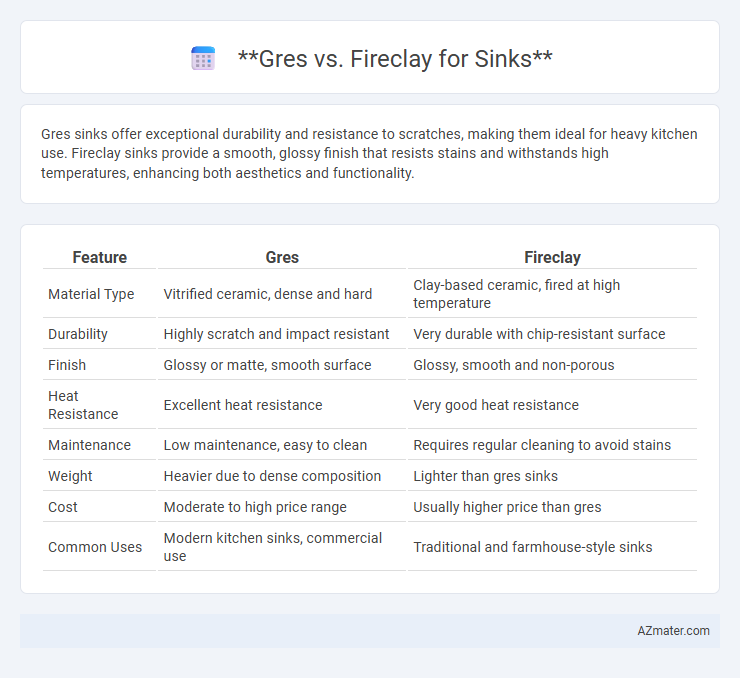Gres sinks offer exceptional durability and resistance to scratches, making them ideal for heavy kitchen use. Fireclay sinks provide a smooth, glossy finish that resists stains and withstands high temperatures, enhancing both aesthetics and functionality.
Table of Comparison
| Feature | Gres | Fireclay |
|---|---|---|
| Material Type | Vitrified ceramic, dense and hard | Clay-based ceramic, fired at high temperature |
| Durability | Highly scratch and impact resistant | Very durable with chip-resistant surface |
| Finish | Glossy or matte, smooth surface | Glossy, smooth and non-porous |
| Heat Resistance | Excellent heat resistance | Very good heat resistance |
| Maintenance | Low maintenance, easy to clean | Requires regular cleaning to avoid stains |
| Weight | Heavier due to dense composition | Lighter than gres sinks |
| Cost | Moderate to high price range | Usually higher price than gres |
| Common Uses | Modern kitchen sinks, commercial use | Traditional and farmhouse-style sinks |
Introduction to Gres and Fireclay Sinks
Gres sinks, crafted from sintered stone materials, offer exceptional durability and resistance to scratching and heat, making them ideal for heavy kitchen use. Fireclay sinks, made from vitrified ceramic clay fired at high temperatures, provide a classic, glossy finish with superior stain and chip resistance. Both materials combine functionality with aesthetic appeal, but Fireclay sinks typically feature smoother surfaces, while Gres sinks emphasize robustness and modern design flexibility.
Material Composition: Gres vs Fireclay
Gres sinks are crafted from ultra-dense stoneware clay, fired at extremely high temperatures to achieve exceptional hardness and chip resistance, making them highly durable and non-porous. Fireclay sinks consist of a refined clay mixture combined with quartz and feldspar, also fired at high temperatures but slightly lower than gres, resulting in a smooth, glossy finish that resists stains and scratches. While gres offers superior structural strength due to its dense composition, fireclay provides a more traditional, glossy aesthetic with excellent resistance to heat and chemicals.
Durability and Strength Comparison
Gres sinks, made from dense porcelain clay, offer exceptional hardness and resistance to chipping, making them highly durable for everyday kitchen use. Fireclay sinks are fired at ultra-high temperatures, resulting in a non-porous, resilient surface that resists scratching and cracking better than many traditional materials. While both exhibit strong durability, fireclay provides superior resistance to thermal shock and heavy impact, often outperforming gres in long-term strength and durability.
Design and Appearance Options
Gres sinks feature a sleek, modern design with smooth, uniform surfaces available in a variety of neutral tones and matte finishes, ideal for minimalist kitchen aesthetics. Fireclay sinks offer a more traditional and artisanal appearance, showcasing glossy, handcrafted textures and a wider palette of vibrant colors that add character and warmth. Both materials provide design versatility, but Gres emphasizes contemporary elegance while Fireclay highlights classic craftsmanship and rich visual depth.
Stain and Scratch Resistance
Gres sinks, made from sintered stone, exhibit exceptional stain resistance due to their non-porous surface that repels liquids and prevents discoloration. Fireclay sinks, crafted from vitrified clay, offer excellent scratch resistance with a durable, glazed finish that withstands everyday wear and tear. Both materials provide robust protection, but Gres is particularly favored for heavy stain resistance, while Fireclay excels in maintaining surface integrity against scratches.
Installation Differences
Gres sinks typically require professional installation due to their heavy weight and brittle nature, demanding precise handling and secure mounting to avoid cracks. Fireclay sinks, although also heavy, allow for easier installation with standard mounting hardware but necessitate careful sealing to prevent water penetration into their porous surfaces. Both materials benefit from reinforced cabinetry and proper support brackets to ensure durability and longevity in kitchen or bathroom setups.
Maintenance and Cleaning Requirements
Gres sinks, made from vitrified porcelain, offer excellent resistance to stains and scratches, requiring minimal maintenance with simple wiping using mild detergents. Fireclay sinks are highly durable and non-porous, making them easy to clean and resistant to bacteria, but they need gentle cleaning to avoid surface chipping or crazing. Both materials benefit from routine cleaning with non-abrasive products to preserve their finish and longevity in kitchen environments.
Cost and Value Analysis
Fireclay sinks typically cost more upfront than gres sinks due to their handcrafted manufacturing process and durable, glaze-fired finish. Gres sinks offer a more budget-friendly option while providing good durability and resistance to stains, making them suitable for cost-conscious consumers. Evaluating long-term value, fireclay sinks tend to retain their appearance and structural integrity longer, potentially reducing replacement and maintenance costs over time.
Environmental Impact
Fireclay sinks are highly durable and made from natural clay, which results in a lower environmental footprint compared to gres sinks that require more energy-intensive manufacturing processes. Gres sinks often involve the use of synthetic materials and glazes that can release harmful pollutants during production and disposal. Choosing fireclay promotes sustainability by utilizing eco-friendly materials and reducing waste through enhanced longevity and biodegradability.
Choosing the Right Sink Material for Your Kitchen
Gres sinks offer exceptional durability and resistance to scratches and stains, making them ideal for heavy kitchen use and modern designs. Fireclay sinks, crafted from highly vitrified clay, provide a classic, glossy finish that resists chipping and maintains its appearance over time, suitable for traditional or farmhouse kitchens. Selecting between gres and fireclay depends on desired aesthetics, durability needs, and maintenance preferences, ensuring your kitchen sink complements both functionality and style.

Infographic: Gres vs Fireclay for Sink
 azmater.com
azmater.com